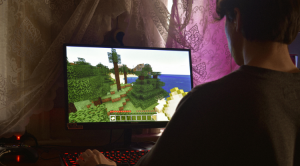Why am I glued to my screen?
If you’ve come to this article, you’re probably asking the question in the title.Fear not, excessive screen time is way more common than you think – and it can be decoded and helped through some basic science and the rest is just what’s worked for me as a teen.

Ok, so you might’ve read fifty articles or self-help books. Gone through three hundred motivational quotes or skimmed through some science articles on this. The truth? As overused as some of the things in this article are, they actually hold true.
A few years ago, during the pandemic, I was also a complete screen addict. It didn’t help that we were all confined to our homes. My average screen time was 7 hours, and there were days when I would spend up to 8 or 9 hours just staring at blue light. On a holiday, my laptop and I were inseparable. When I got back from school, I’d hop on Minecraft and grind away. I was pretty much spending 80% of my day doing nothing on the screen, and most of the time, I ended up getting zero exercise. Now, this went on for about two years or so. Wake up, school, return, play video games, watch YouTube, go to bed at like 11 PM. When I think back now, I feel kind of disgusted. So, what’s changed between now and then?
Firstly, by no means am I completely off the screen. I still occasionally spend hours doing nothing or get caught up in scrolling. I still end up procrastinating – yes, it’s far from perfect. But, at least, it’s an improvement. Here’s the science behind screen addiction – and the methods that helped me escape it (and still help me out on a day-to-day basis):
Blame it on dopamine
Ah yes – the golden word. Dopamine. You’ve probably read this many times before, yet research constantly backs this fact. Things like notifications, social media, and video games trigger the brain’s nucleus accumbens – a part of the brain responsible for releasing dopamine. This makes you feel good and makes you want to repeat the actions that lead to releasing more dopamine.
In fact, the dopamine loop activated by screen stimuli is similar to the effects of cocaine and similar substances. Pretty quickly, this constant release of dopamine makes you crave quick rewards, which can be problematic as it rewires your brain to avoid hard work, longer periods of concentration, and expect instant gratification.
The problem here? The truth is, pretty much everything in real life requires delayed gratification. Success isn’t instant, and you don’t get instant feedback after you do something. You solve a math problem, there’s no on-the-spot confetti or a “victory royale” sign when you do it – you just crack on with the next one. So when you score high on the end-of-year exam, it’s months of quiet, consistent effort, not instant knockouts. And that’s pretty much how real life is.
They want you hooked
It becomes harder to beat the system when you realize that the people who made the apps you’re using actually use science and psychology to ensure it’s addictive. Many social media apps and video games are deliberately designed with that goal: to keep users hooked. Behind the scenes, their teams brainstorm new ways to make users scroll… and scroll… and scroll.
Take the example of the beloved video game, Fortnite. Battle passes, loot boxes, frequent updates – all carefully designed mechanisms to keep users playing, gradually getting them addicted. YouTube, Instagram work similarly. You swipe… and swipe… and then swipe again.
Hey! Someone liked my post!
Oh no… so many dislikes too…
Yeah, so it’s pretty easy to get addicted when the guys who make your apps literally want you to.
Your brain is lazy too
Science suggests that the human brain aims to conserve energy. If a task can be done with less effort, it’ll go for it. This is fine because it can help one work more efficiently, but it quickly becomes problematic when amplified with things like social media and gaming.
Let’s say you have an exam to prepare for. Now, studying requires active concentration and genuine effort. Scrolling through Insta? Requires nothing other than mechanical finger swiping. So your brain will probably go towards the latter.
But research also finds that the brain thrives on challenges, too, and gains a higher sense of accomplishment after completing effortful tasks. When immersed in a deeply challenging task, the brain enters into a “flow” state, which is a state of total concentration where the brain focuses entirely on the task at hand. The activity feels rewarding and enjoyable, and the effort begins to feel effortless.
It’s easy to numb your brain scrolling or tapping away at a screen, but way more challenging to put in genuine effort. It’s harder to reach a flow state than waste time, even though you’ll feel a lot more accomplished after completing a challenging task than doing nothing.
Ok, so that’s the bad (but real) stuff. Now, how can you escape this matrix? I’ll share a few things that significantly helped me, so hopefully they can start you on your journey from 5% productivity to at least doing the important stuff:
1. Change your mindset
Nothing will really work if you don’t begin with a change in your mindset. Go from thinking “How can I enjoy myself?” to “How can I make a real difference?” or “What’ll set me up for success?”. A good book I’d recommend is Atomic Habits, which emphasizes that the first step to breaking a bad habit is to change your worldview. Only when you personally want to do things differently will you actually make a change.
2. Pick up a sport
Most of the time, people will just tell you: “get some exercise”. But I find it’s even more effective when you play a sport, because it’s more likely that you’ll enjoy yourself. For me, this was chess and cricket. Pick up any sport you like watching, or have enjoyed playing, and take it up seriously. Be consistent; put in an hour or more every day, and you’ll start seeing progress and feel a sense of accomplishment.
3. Start small
It might be daunting to suddenly turn around your life in a day, so you can start with the little things. I started with: “Instead of playing Minecraft from 5:00-6:00, can I play chess instead?” and worked my way up from there. Basically, replace each wasted hour with something more useful. So instead of scrolling through reels before dinner, you can decide to revise old math concepts or go through your chemistry notes.
4. Plan your day
Ok, this is one of my father’s. He always says it helped him. It’s a habit I’m also trying to build: keeping a routine diary. Just before going to bed or after waking up, decide what you’re going to do the next day. What’s your main goal going to be? Fill up each hour of the day with meaningful activities – what are you going to do when you come from school? When are you going to revise biology? When will you eat dinner? Pack in your schedule completely so you don’t have any time to waste and meander over to the screen. It’s difficult to start habits like this, so, once again, I’d recommend the book Atomic Habits to understand the science behind cultivating and maintaining habits.
5. Discipline > 3am motivation
Motivation is the desire to act. Discipline is the ability to act when that desire is absent. Long-term habit building and success come through building discipline, not relying on fleeting sparks of that 3 AM motivation. Nobody’s perfect in this! Focus on building discipline instead of constantly trying to whip yourself into a burst of motivation. Motivation can be that initial spark, but it’s discipline and only discipline that’ll keep you pushing forward.
Remember, everything is usually fine in moderation. You can set aside an hour a day or so to catch up on whatever you wish to do on the screen, but it’s important to practice good digital hygiene and keep track of your time. From all that I’ve read and am still figuring out (big time!) — it’s a mix of your overall mindset, discipline, and habits that will propel you forward, but hey, you find that out on your own.
Do you have any questions for Science Lab? Post them in the comments box below. We will respond to them in our upcoming articles. Please don’t put any personal information.


